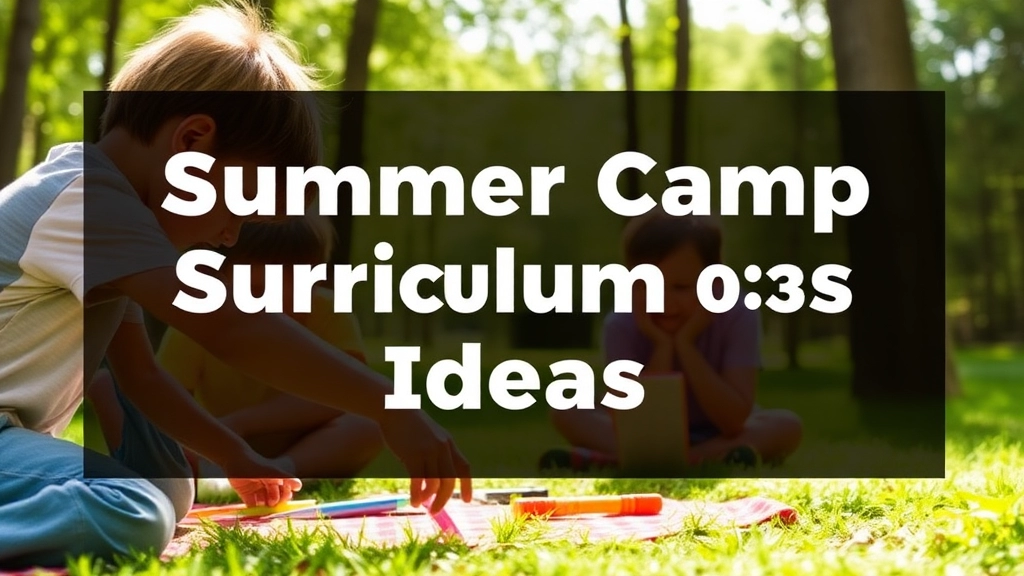Transform Your Summer Camp
Are you ready to transform your summer camp into an unforgettable adventure? Crafting an engaging summer camp curriculum is no small feat, but with the right mix of fun and educational activities, you can keep kids excited and parents thrilled. From theme-based learning to STEM and STEAM focused camps, creative arts, and outdoor adventures, this guide covers it all. Let’s dive into the essential elements that will make your summer camp stand out!
Essential Elements
We’ll explore how to incorporate community and inclusivity, design low-prep and flexible lesson plans, and continuously improve through evaluation and feedback. Whether it’s water activities or creative arts, each section is packed with practical ideas and real-life examples to inspire you.
Get Started
Ready to make this summer the best one yet? Let’s get started with these summer camp curriculum ideas!
Building an Engaging Summer Camp Curriculum
Alright, let’s dive in. So, you’re tasked with building an engaging summer camp curriculum. Where do you start? How do you make it fun, educational, and something kids will actually look forward to? I’ve been there, and I get it. You want to avoid the eye-rolls and the “I’m bored” complaints. Let’s break it down, step by step.
Why a Good Curriculum Matters
First off, why should you even care about a well-structured curriculum? Simple. A solid curriculum keeps kids engaged, ensures they’re learning something valuable, and makes your life easier. Plus, happy kids mean happy parents, and that’s a win-win.
Start with the Basics
Before diving into the fun stuff, nail down the basics:
- Age Groups: Tailor activities to different age groups. What works for a 6-year-old won’t fly with a 12-year-old.
- Interests: Find out what kids are into these days. Is it dinosaurs, space, or maybe coding? Use that info to your advantage.
- Safety: This one’s non-negotiable. Ensure every activity is safe and age-appropriate.
Mix It Up
Variety is the spice of life, right? The same goes for your summer camp curriculum. Mix academic learning with fun activities. Here’s a quick list to get you started:
- Academic Enrichment: Think science experiments, reading time, and educational games.
- Creative Arts: Drawing, painting, and even some drama activities.
- Physical Activities: Sports, obstacle courses, and team-building exercises.
- Outdoor Adventures: Nature walks, scavenger hunts, and camping basics.
Incorporate Themes
Themes can make your curriculum more cohesive and engaging. Imagine a week dedicated to “Space Exploration” where every activity ties back to that theme. Kids will love it, and it makes planning easier for you.
Real-Life Example
Let me share a quick story. Last summer, I was working on a camp curriculum, and we decided on a “Superhero Week.” Each day had activities like designing superhero costumes, obstacle courses to “train” like a superhero, and even a mini science lab to create “super potions.” The kids were all in, and it made the week fly by. Plus, parents loved the creativity.
Use Feedback
Don’t be afraid to tweak your curriculum based on feedback. If an activity flops, scrap it. If kids love something, double down on it. Flexibility is key.
Quick Tips
- Bullet Points: Use them to make info digestible.
- Tables: Great for schedules or comparing activities.
- Bold Highlights: Emphasize important points.
If you’re looking for some inspiration, check out these summer camp bulletin board ideas or explore fun activities at summer camps to spark your creativity.
Theme-Based Learning Activities
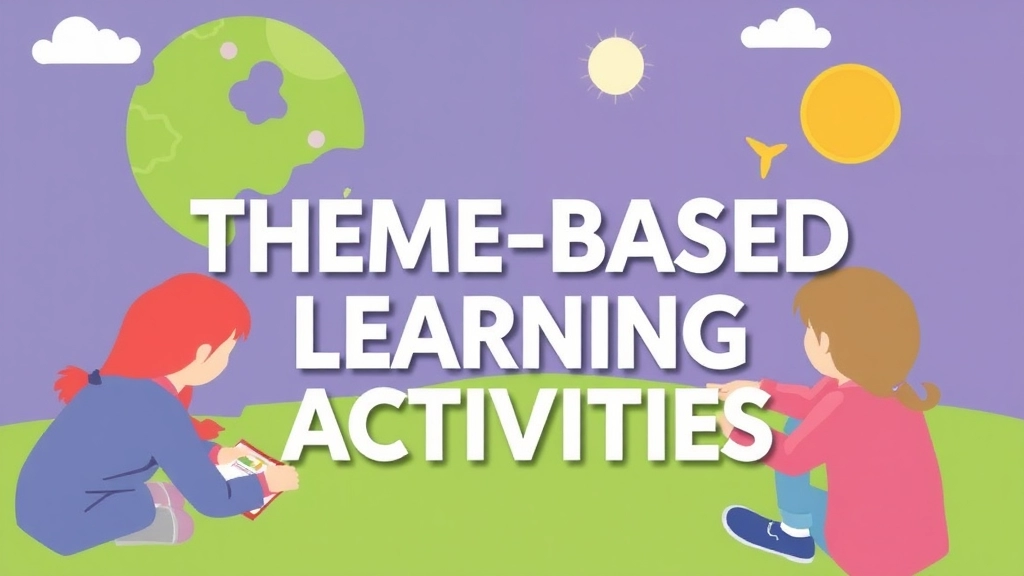
Ever struggled to keep kids engaged during summer camp?
You’re not alone.
Parents and camp organisers alike want something fresh and exciting.
That’s where theme-based learning activities come in.
What’s the Big Deal with Themes?
Themes make learning fun.
They give structure to the chaos.
Imagine a pirate week where kids learn geography by ‘discovering’ new lands.
Or a science week with hands-on experiments.
Themes turn everyday activities into adventures.
Types of Themes to Consider
- Nature Exploration
- Nature walks
- Plant identification
- Eco-friendly crafts
- Space and Beyond
- Star gazing
- Rocket building
- Space-themed stories
- Historical Adventures
- Time-travel treasure hunts
- Ancient civilisation projects
- Interactive history lessons
Why Themes Work
Themes create a sense of anticipation.
Kids know what to expect but are also curious about what’s next.
It keeps them coming back for more.
How to Implement Themes
- Plan Ahead: Map out your themes before camp starts.
- Be Flexible: Allow room for spontaneous fun.
- Get Creative: Use everyday items to bring themes to life.
Real-Life Example
Last summer, we ran a “Superheroes” week.
Kids created their own superhero personas.
They designed costumes and even wrote short comic strips.
By the end of the week, they were more confident and had a blast.
The Benefits
- Engagement: Keeps kids interested.
- Learning: Makes education fun.
- Memorable: Creates lasting memories.
STEM and STEAM Focused Summer Camps
Are you worried that your kid’s summer will be a waste of time? Wondering how to keep them engaged while also learning something valuable? That’s where STEM and STEAM focused summer camps come in.
Why STEM and STEAM?
STEM (Science, Technology, Engineering, and Mathematics) and STEAM (adding Art to the mix) camps aren’t just a trendâthey’re essential. They help kids develop critical skills like problem-solving, creativity, and collaboration. Plus, they’re a blast!
Key Benefits of STEM and STEAM Camps:
- Hands-On Learning: Kids get to build, experiment, and create, which makes learning fun and memorable.
- Future-Ready Skills: These camps prepare children for future careers in tech, engineering, and creative fields.
- Increased Engagement: When kids are genuinely interested, they learn better and retain more information.
Types of Activities:
- Coding and Robotics:
- Beginner Coding: Simple programming languages like Scratch.
- Robotics Kits: Building and programming robots using LEGO Mindstorms or similar kits. For more information on coding camps, check out our coding summer camps in Highlands Ranch.
- Science Experiments:
- Chemistry: Safe, fun experiments like making slime or volcanoes.
- Physics: Simple projects like building bridges with popsicle sticks.
- Engineering Challenges:
- Design Projects: Create structures with everyday materials.
- Problem-Solving Tasks: Real-world problems that need innovative solutions.
- Art and Technology Integration:
- Digital Art: Using software to create digital masterpieces.
- 3D Printing: Designing and printing small objects. For more creative ideas, explore our summer camp activities.
How to Make It Engaging:
- Storytelling: Frame activities around a narrative. For example, “Today, we’re building a robot to save a fictional city!”
- Gamification: Incorporate elements of game design, like points and rewards, to keep kids motivated.
- Collaborative Projects: Encourage teamwork to solve complex problems.
Real Stories, Real Impact:
I remember one summer camp where a group of kids built a robot that could navigate a maze. They were so engaged that they didn’t even realise they were learning complex coding and engineering concepts. By the end of the camp, they were not just better coders but also better problem solvers and team players.
Tips for Parents:
- Ask About Interests: Find out what excites your child. Do they love art? Maybe a STEAM camp is more suitable.
- Check the Curriculum: Ensure the camp includes a variety of activities to keep things fresh and engaging.
- Get Feedback: Talk to your child after each day to see what they enjoyed and what they didn’t. This can help you choose better camps in the future.
Creative Arts and Expression in Summer Camps
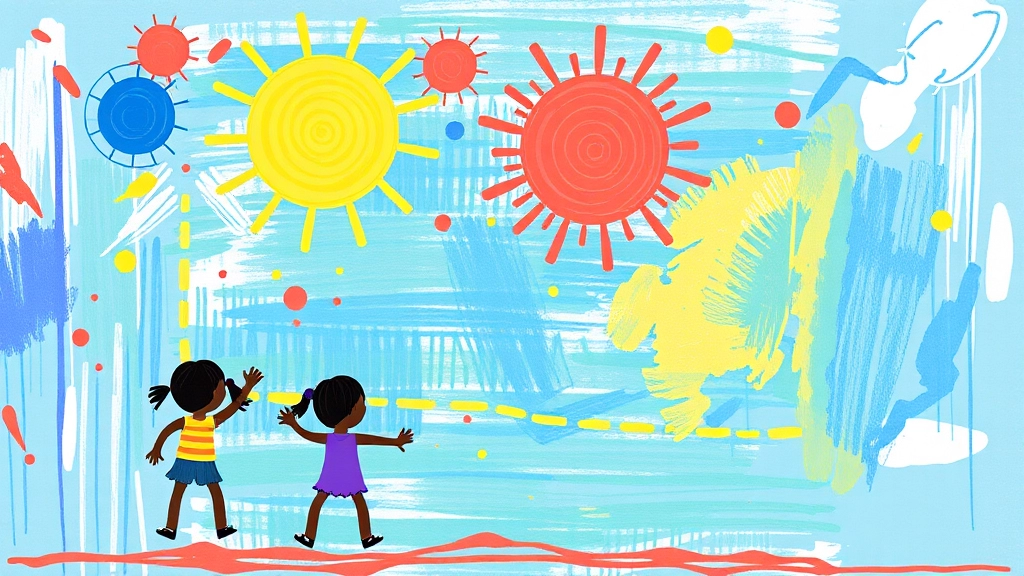
Ever wonder how to keep kids engaged and excited at summer camp?
Creative arts and expression might just be your secret weapon.
Kids love to create.
They love to express themselves.
But how do you make it fun and educational at the same time?
Let’s dive into it.
Why Creative Arts Matter
First off, why bother with creative arts?
- Kids develop critical thinking and problem-solving skills.
- It boosts self-esteem and confidence.
- Encourages teamwork and collaboration.
Got it? Great, let’s move on.
Types of Creative Activities
Here’s a list to get you started:
- Painting and Drawing
- Keep it simple.
- Provide a variety of materials like watercolours, crayons, and markers.
- Encourage kids to draw their favourite summer memory.
- Crafts
- Think beyond paper and glue.
- Use recyclable materials.
- Make friendship bracelets or DIY bird feeders.
- Drama and Theatre
- Perfect for those who love to perform.
- Simple skits or improv games can be a hit.
- Let them write and perform their own short plays.
- Music and Dance
- Create a camp band.
- Teach them a fun dance routine.
- Have a talent show at the end of the week.
How to Keep It Fresh
- Rotate activities to keep things exciting.
- Mix up individual and group projects.
- Incorporate themes that tie into your overall camp curriculum.
Real-Life Example
Last summer, I had a group of kids who were super shy.
We started with simple drawing projects.
By the end of the week, they were performing in a camp-wide talent show.
Talk about a transformation.
Tips for Success
- Keep it simple: You don’t need fancy supplies.
- Be flexible: Not every kid will love every activity.
- Encourage expression: There’s no right or wrong in art.
Physical and Outdoor Adventure Activities
Are you worried that your summer camp might end up being just another boring experience for kids? Trust me, we’ve all been there. The secret sauce to an unforgettable summer camp is physical and outdoor adventure activities. Let’s dive into what makes these activities a game-changer and how you can master them.
Why Physical and Outdoor Activities Matter
First off, why should you even bother with outdoor activities? Let me break it down:
- Health Benefits: Kids today spend way too much time indoors. Outdoor activities boost physical health, improve mental well-being, and even enhance social skills.
- Team Building: These activities foster teamwork and cooperation. When kids work together to solve problems, they build friendships that last a lifetime.
- Confidence Boost: Facing and conquering physical challenges gives kids a massive confidence boost. They learn they can achieve more than they thought possible.
Types of Outdoor Adventure Activities
Okay, let’s get into the nitty-gritty. What kinds of activities should you include? Here are some top picks:
- Hiking and Nature Walks
- Explore local trails and natural parks.
- Teach kids about local flora and fauna.
- Obstacle Courses
- Set up simple obstacle courses.
- Use everyday items like ropes, tires, and cones.
- Water Sports
- Canoeing, kayaking, and paddleboarding.
- Always prioritise safety with life jackets and trained instructors.
- Camping
- Overnight camping trips.
- Teach basic survival skills like setting up tents and making a campfire.
- Scavenger Hunts
- Create themed scavenger hunts.
- Use clues that require teamwork to solve.
Pro Tips for Successful Outdoor Activities
Now, let’s get practical. Here are some tips to make sure your outdoor activities are a hit:
- Safety First: Always have a first-aid kit and trained staff on hand.
- Flexible Schedules: Weather can be unpredictable. Have backup plans ready.
- Inclusive Activities: Make sure activities are accessible to all kids, regardless of their physical abilities.
Real Stories, Real Success
Let me share a quick story. Last summer, we had a shy kid named Jamie who was terrified of heights. We encouraged him to try the zip line, and guess what? Not only did he conquer his fear, but he also became the camp hero. His confidence skyrocketed, and he made friends instantly. That’s the magic of outdoor activities.
Incorporating Community and Inclusivity
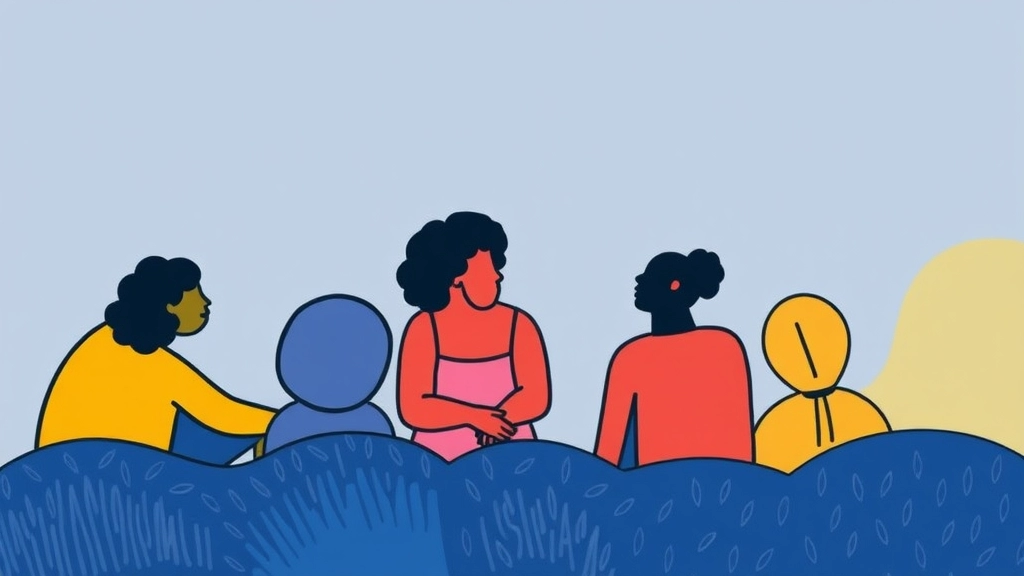
Ever wondered how to make your summer camp feel like a second home for every kid?
How do we ensure every child feels included and part of the community?
These are real questions we all face when planning a summer camp.
And trust me, it’s easier than you think.
Why Community and Inclusivity Matter
First off, let’s talk about why this is crucial.
Kids thrive in environments where they feel accepted.
They learn better, have more fun, and are more likely to make lasting memories.
Here’s how we can do it:
Get Everyone Involved
- Open Communication: Make it clear from day one that everyone’s voice matters.
- Buddy Systems: Pair up kids from different backgrounds to help them bond.
- Family Days: Invite parents and siblings to join in on the fun. This creates a sense of community beyond just the kids.
Celebrate Differences
- Cultural Days: Dedicate days to celebrating different cultures. Food, music, and games from around the world can make this super fun.
- Inclusive Games: Choose activities that everyone can participate in, regardless of physical ability.
- Story Sharing: Create sessions where kids can share stories from their lives. It builds empathy and understanding.
Create Safe Spaces
- Quiet Zones: Not every child is an extrovert. Have areas where kids can relax and recharge.
- Counsellor Check-ins: Regular one-on-one time with counsellors to ensure every child feels heard and valued.
- Anti-Bullying Policies: Make it clear that bullying won’t be tolerated. Set up systems for kids to report issues anonymously if needed.
Real Stories, Real Impact
Last summer, we had a camper named Ben.
He was shy and didn’t know anyone.
We paired him with Sam, a camper who had been with us for years.
By the end of the week, Ben was leading group activities.
Sam said it was the best summer ever because he got to help someone else.
That’s the power of community and inclusivity.
Keep it Fresh and Fun
- Weekly Themes: Change themes weekly to keep things exciting. One week could be ‘Space Week’, the next ‘Jungle Adventure’.
- Interactive Workshops: Bring in local artists, scientists, or athletes to run workshops. It gives kids new role models and fresh perspectives.
Low-Prep and Flexible Lesson Plans
Ever felt overwhelmed by the sheer amount of prep work for summer camp activities? You’re not alone. Many camp organisers face the same challenge. But guess what? You can create engaging, educational, and fun lesson plans without spending hours on preparation. Let’s dive into some practical tips that can save you time and keep the kids excited.
Why Low-Prep?
First off, why should you care about low-prep lesson plans? Here are some real concerns:
- Time Constraints: We all have a million things to juggle. Who has the time to plan every single detail?
- Flexibility: Kids are unpredictable. Your lesson plan should be able to adapt on the fly.
- Resource Availability: Sometimes, you just don’t have all the materials you planned for.
Quick and Easy Lesson Ideas
So, what are some low-prep activities that still pack a punch? Here are a few to consider:
- Storytelling Circles:
- Materials Needed: Just your imagination.
- Activity: Sit in a circle and take turns adding to a story. You can start with a prompt like, “Once upon a time, in a land filled with talking animals…”
- Why It Works: It fosters creativity and teamwork without any prep.
- Nature Scavenger Hunt:
- Materials Needed: A list of items to find (e.g., a leaf, a rock, something red).
- Activity: Kids go on a hunt around the camp to find the items on the list.
- Why It Works: It’s engaging, gets kids moving, and requires minimal prep.
- DIY Crafts with Recyclables:
- Materials Needed: Old newspapers, cardboard, bottle caps, etc.
- Activity: Let kids create whatever they want using these materials.
- Why It Works: Encourages creativity and is eco-friendly.
Adaptability is Key
Flexibility is crucial in a camp setting. One minute it’s sunny, and the next it’s pouring rain. Here’s how to stay adaptable:
- Have Backup Plans: Always have a couple of indoor activities ready in case the weather turns.
- Mix and Match: Combine different activities to keep things fresh. For example, pair a scavenger hunt with a short craft session.
- Kid-Led Activities: Sometimes, let the kids decide what they want to do. It’s less prep for you and more fun for them.
Real-Life Example
I remember one summer, we had planned an elaborate outdoor obstacle course. But, as luck would have it, it rained cats and dogs. Instead of panicking, we quickly switched to an indoor talent show. The kids loved it, and it required zero prep. Just a quick rearrangement of chairs and a makeshift stage. It turned out to be one of the highlights of the camp.
Internal Linking Opportunities
For more ideas on theme-based learning activities, check out the Creative Summer Camp Themes for All Ages section. If you’re interested in incorporating some STEM elements, head over to STEAM Summer Camp: Your Ultimate Guide. And don’t forget about the Top Summer Camp Gifts for Every Camper for those sunny days.
Evaluation and Feedback for Continuous Improvement
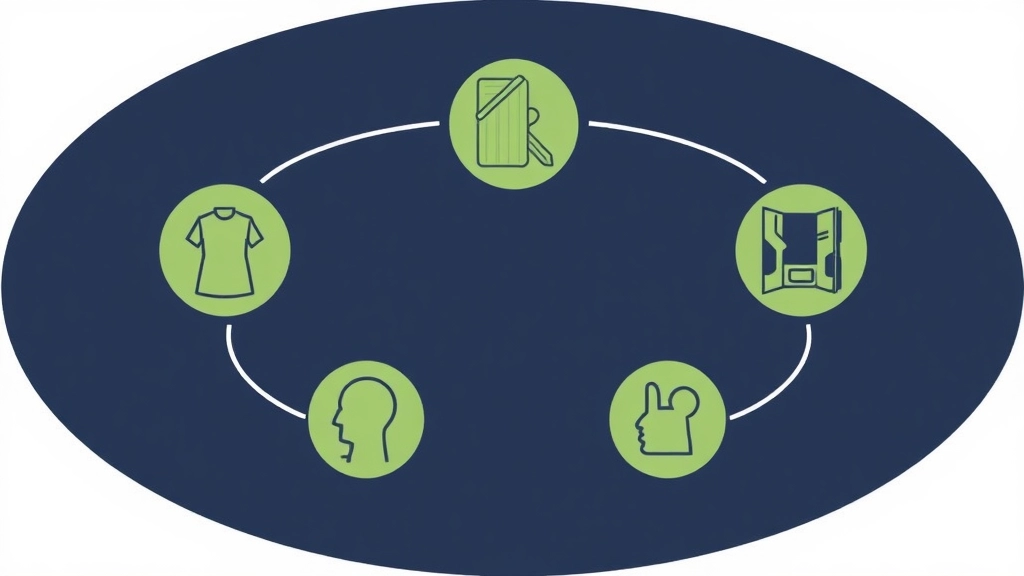
Ever wonder if your summer camp is actually hitting the mark?
We all do.
You spend hours planning, but how do you know it’s working?
That’s where evaluation and feedback come in.
Why Evaluation and Feedback Matter
Without feedback, you’re flying blind.
You need to know what’s working and what’s not.
Simple as that.
How to Gather Feedback
- Surveys: Hand out quick surveys to campers and parents. Keep them short and sweet.
- One-on-One Chats: Sit down with campers. Ask them what they loved and what they didn’t.
- Observation: Watch how kids interact with activities. Are they engaged or bored?
Types of Feedback to Look For
- Engagement Levels: Are kids excited to participate?
- Learning Outcomes: Are they actually learning something new?
- Fun Factor: Are they having fun? This is a camp, after all.
- Safety: Were there any safety concerns?
Implementing Changes
Feedback is useless if you don’t act on it.
Here’s how to do it:
- Identify Key Issues: Look for common themes in the feedback.
- Prioritize: Not all feedback is equal. Focus on the big wins.
- Make a Plan: Lay out steps to address the issues.
- Communicate Changes: Let everyone know what’s changing and why.
Real-Life Example
Last summer, we noticed a dip in engagement during our STEM activities.
Kids were zoning out.
We asked them why.
Turns out, the sessions were too long.
We shortened them and added hands-on projects.
Guess what?
Engagement shot up.
Continuous Improvement
This isn’t a one-time thing.
Make feedback a regular part of your camp routine.
It’s the only way to keep getting better.
Wrap-Up
Evaluation and feedback are your best friends.
They help you tweak, improve, and perfect your summer camp curriculum.
Don’t skip this step.
Your campers will thank you.
Got any more tips on gathering feedback?
Share them below!
Keep it real, keep it fresh, and keep it engaging.
Water and Outdoor Activities for All Ages
Ever wondered how to keep kids entertained and active during summer camp?
Water and outdoor activities are the answer.
They’re not just funâthey’re essential.
Why Water Activities?
- Safety First: Always have lifeguards and follow safety protocols.
- Engagement: Water games keep kids cool and engaged.
- Variety: From swimming to water balloon fights, there’s something for everyone.
Popular Water Activities
- Swimming: Classic and always a hit.
- Water Balloon Fights: Fun and easy to set up.
- Slip ‘N Slide: Simple but tons of fun.
- Kayaking/Canoeing: Great for older kids and teens.
Outdoor Adventures
- Hiking: Connects kids with nature.
- Obstacle Courses: Builds teamwork and physical skills.
- Scavenger Hunts: Combines adventure with learning.
Making It Inclusive
- Adaptability: Ensure activities are accessible to all kids.
- Buddy System: Pair kids up to encourage inclusion.
Real-Life Example
Remember that summer camp where we had a massive water balloon fight?
Kids still talk about it.
It’s those memorable moments that make summer camp special.
Tips for Success
- Plan Ahead: Have all equipment ready.
- Safety Gear: Always use life jackets for water activities.
- Flexibility: Be ready to adapt based on the weather.
For more ideas on keeping your camp engaging, check out our top outdoor games for summer camp and explore the fun activities of summer camp Olympic games.
FAQs on Summer Camp Curriculum Ideas
What are theme-based learning activities?
Theme-based learning activities use a central theme to structure various educational and fun activities. For example, a pirate week could involve geography lessons by ‘discovering’ new lands, or a science week could include hands-on experiments.
Why are themes important in a summer camp curriculum?
Themes create a sense of anticipation and excitement. They provide structure and turn everyday activities into adventures, keeping kids engaged and curious about what’s next.
What types of themes can be used in a summer camp?
Some popular themes include Nature Exploration, Space and Beyond, and Historical Adventures. Each theme can have specific activities like nature walks, star gazing, or time-travel treasure hunts.
How can I implement themes effectively in my summer camp?
Plan your themes ahead of time, be flexible to allow spontaneous fun, and get creative by using everyday items to bring themes to life.
What are the benefits of using themes in summer camps?
Themes help in keeping kids engaged, making education fun, and creating lasting memories.
Why should creative arts be included in a summer camp curriculum?
Creative arts help kids develop critical thinking and problem-solving skills, boost self-esteem and confidence, and encourage teamwork and collaboration.
What types of creative activities can be included in a summer camp?
Activities can include Painting and Drawing, Crafts, Drama and Theatre, and Music and Dance. Each category offers a variety of projects to keep kids engaged and excited.
How can I keep creative activities fresh and exciting?
Rotate activities, mix up individual and group projects, and incorporate themes that tie into your overall camp curriculum.
Why is community and inclusivity important in a summer camp?
Kids thrive in environments where they feel accepted. It enhances their learning experience, makes the camp more fun, and helps in creating lasting memories.
How can I foster a sense of community and inclusivity in my camp?
Encourage open communication, use buddy systems, celebrate cultural differences, and create safe spaces for kids to relax and recharge.
Why is evaluation and feedback crucial for a summer camp?
Evaluation and feedback help you understand what’s working and what’s not. They provide insights to improve your camp activities and ensure a better experience for the kids.
How can I gather feedback effectively?
Use surveys, conduct one-on-one chats with campers, and observe how kids interact with activities. Look for engagement levels, learning outcomes, fun factor, and safety concerns.
What should I do with the feedback I receive?
Identify key issues, prioritize them, make a plan to address the issues, and communicate the changes to everyone involved. This ensures continuous improvement in your camp curriculum.
Can you give an example of how feedback improved a summer camp activity?
Last summer, we noticed a dip in engagement during our STEM activities. After gathering feedback, we found that the sessions were too long. We shortened them and added hands-on projects, which significantly increased engagement.
References
-
Theme-Based Programming – American Camp Association
-
50 Summer Camp Themes – Care.com
-
The Importance of Feedback in Summer Camp – Camp Nurse

